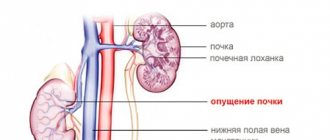Some will say that bags under the eyes are just a cosmetic problem. Someone will think: well, I didn’t get enough sleep today, tomorrow I won’t even remember about it. But if, looking in the mirror every morning, you see swelling on your face, this is a reason to think, is it just a lack of sleep?
To make it clearer, let's say a few words about the anatomy of the orbit. The eyeball is a rather fragile organ and needs protection. Therefore, in the orbit it is surrounded on all sides by fatty tissue, which protects and cushions it. Separating this impressive amount of fat, called periorbital fat, from the delicate skin of the eyelids is a thin layer of connective tissue (membrane). It does not allow the periorbital tissue to extend beyond the orbit.
Anatomy of the orbit. In the figure 1 - periocular tissue, 2 - eyeball, 3 - membrane
Causes of kidney swelling
It is worth understanding that it is edema and swelling of the face/arms/legs that are the first signs of poor-quality kidney function.
It is worth understanding that it is edema and swelling of the face/arms/legs that are the first signs of poor-quality kidney function. And if they are additionally loaded in the evening with a large amount of liquid, alcohol or salty food, then the morning picture will not please them at all. Since facial puffiness is one of the clinical signs of nephrotic syndrome in the following pathologies of the urinary organs:
- Pyelonephritis. Simply put, an inflammatory process in the calyx-pelvic region of the kidneys. As a rule, it develops against the background of a previous viral infection. In this case, bacteria/Escherichia coli, etc. penetrate the kidneys, where they stimulate the inflammatory process. The pathology can occur quite latently with unexpressed symptoms, which are often interpreted as tired person syndrome.
- Glomerulonephritis. Or inflammation of the glomerular apparatus of the kidneys. It develops as an independent disease after suffering from hypothermia. In this case, the kidneys simply do not have time to filter the blood, which leads to excessive swelling.
- Benign and malignant formations in the kidneys. Growing in the kidney parenchyma, such tissues compress the vessels of the urinary organs (nephrons), which leads to a decrease in kidney function.
- Nephropathy of pregnancy. In expectant mothers, the growth of the fetus and uterus moves the kidneys up or down relative to their normal position. In this case, the urinary tract and ureters become overloaded, making it difficult to evacuate urine. Accordingly, fluid is retained in the body.
- Toxic nephropathy. Or simply severe poisoning of the body with toxic substances, which leads to kidney failure. At risk are alcoholics and drug addicts, people working in chemical and toxic industries.
In addition, it is worth understanding that nephrotic syndrome (namely reduced kidney function) can also develop as a pathology concomitant with other diseases. These are:
Causes of tingling in the kidneys: diagnosis and treatment
- Heart failure;
- Liver failure;
- Problems with blood vessels;
- Autoimmune processes in the body;
- Viral infections;
- Diseases of the lymphatic system;
- Urolithiasis disease.
Bags under the eyes are a sign of kidney disease
In the vast majority of cases, bags under the eyes are a sign that the kidneys are not functioning properly.
Kidneys
Swelling is a very common reason for visiting a doctor. They are a sign of many pathologies of the cardiovascular, endocrine and urinary systems.
Bags under the eyes
If they are localized in the face area, that is, bags appear under the eyes, eyelids swell, then this often indicates kidney disease.
The main cause of edema is a violation of water-salt metabolism.
And the main role in maintaining a constant volume of fluid in the organs and tissues of the body, controlling the concentration of electrolytes in the blood, such as sodium, chlorine, potassium, belongs to the kidneys.
With renal pathology, bags under the eyes appear as a result of sodium retention in the body and a violation of oncotic pressure in the tissues.
Regulation of the content of some microelements, including sodium, is carried out during the formation of urine. This process takes place in specific kidney cells – nephrons.
If they are affected by the disease, their functions are impaired and the concentration of sodium in the tissues increases.
In addition, the kidneys secrete a biologically effective substance - renin, which also takes part in the regulation of electrolyte metabolism.
Oncotic pressure is a very important factor that affects the volume of intercellular fluid. A blood protein, albumin, plays an important role in maintaining constant levels.
If the secretory function of the kidneys is impaired, it is excreted in the urine. Hypoalbuminemia syndrome develops, which manifests itself in a decrease in the concentration of albumin in the blood.
Facial tissues, especially around the eyes, are very sensitive to such pathological changes in the body. Therefore, swelling or bags, as they are called in everyday use, form almost immediately under the eyes.
Pathologies of the urinary system that cause swelling
If a person’s kidneys are affected, this can be determined with the naked eye. He usually has a pale, puffy face. There are pronounced bags under the eyes and swelling on the eyelids.
High swelling
Many kidney diseases affect the parenchyma of the organ, where the main cells - nephrons - are located. That is why the symptoms of such diseases are largely similar.
This complex of manifestations of renal pathology is called nephrotic syndrome.
Depending on the cause, primary and secondary nephrotic syndrome are distinguished.
Primary nephrotic syndrome appears as a result of such diseases:
- acute and chronic glomerulonephritis. This is an inflammation of the nephron glomeruli, which is caused by a malfunction of the human immune system; this process always affects both kidneys;
- amyloidosis. With this disease, atrophy of the kidney tissue occurs due to the deposition of a specific protein-polysaccharide complex in it;
- nephropathy of pregnancy. This is a fairly rare form of toxicosis in late pregnancy, which leads to damage to the nephron tubular system;
- pyelonephritis. This is an inflammation that affects the storage system of the kidney - the calyx and pelvis, but sometimes also affects the parenchyma. The development of nephrotic syndrome with this infectious disease occurs infrequently;
- kidney tumors.
Kidney diseases
Secondary nephrotic syndrome is formed as a result of some systemic diseases of the body, such as:
- collagenoses – systemic lupus erythematosus, periarteritis nodosa, systemic scleroderma;
- vasculitis;
- rheumatoid arthritis;
- diseases of the endocrine system – diabetes mellitus;
- blood diseases - lymphomas;
- chronic purulent processes;
- severe infections - tuberculosis, syphilis, malaria;
- oncological diseases.
Symptoms of nephrotic syndrome
There are several variants of the course of nephrotic syndrome. Episodic, which appears from time to time. Clinical manifestations are very mild and disappear quickly.
Kidney problems
Persistent may last for several years. Its danger lies in the fact that even with active treatment it can develop into chronic renal failure.
Progressive is characterized by a rapid and acute course, severe symptoms, and chronic renal failure develops very quickly.
This condition is characterized by the following symptoms:
- general weakness, drowsiness, fatigue;
- the appearance of swelling, especially pronounced bags under the eyes;
- nausea, possible vomiting;
- decrease in the volume of urine excreted;
- constant thirst;
- dry mouth;
- persistently elevated blood pressure;
- possible increase in temperature;
- Sometimes there is pain in the lumbar region.
Analysis of urine
In the absence or ineffectiveness of treatment, bags under the eyes are accompanied by swelling of the ankles, legs, and lower back. Heart rhythm disturbances and shortness of breath appear.
Changes in clinical urine analysis are also very pronounced. In case of development of pyelonephritis, an increase in leukocytes and bacteria is detected.
With glomerulonephritis, the concentration of leukocytes is insignificant, but the red blood cells are increased.
But if there are bags under the eyes, then the level of protein in the urine will always be significantly increased.
For differential diagnosis of diseases that led to nephrotic syndrome, ultrasound, X-ray studies with contrast, and MRI are performed.
Treatment and prevention
If bags under the eyes appear, but no other symptoms are observed, then first of all you should follow a diet. It is necessary to limit salt intake and not overuse mineral waters.
Drinks containing caffeine are especially dangerous in this condition. They not only have a diuretic effect, but also dull thirst. You also need to limit protein foods in your diet.
Pumpkin, freshly squeezed vegetable and unsweetened fruit juices are very useful. It is very important to completely give up alcohol, beer is especially harmful. Drinking plenty of fluids at night can help with the appearance of bags under the eyes.
If your condition worsens or other symptoms appear, you should consult a doctor. After a comprehensive examination and diagnosis, adequate drug treatment will be prescribed.
To prevent bags under the eyes and “clean” the kidneys, herbal medicine will also be useful. Infusions or decoctions of kidney tea (orthosiphon), bearberry, lingonberry, corn silk, cornflower, and juniper fruit will be very helpful.
promoipochki.ru
Etiology of swelling formation
The water-salt balance in the body is disrupted, which leads to bags, first under the eyes, and then to swelling in the arms and legs.
All processes associated with fluid retention in the body vary depending on the disease occurring in the kidneys. So, the formation of edema may look like this:
- Decreased urination and corresponding sodium retention in the blood. In this case, the blood volume increases, which provokes swelling.
- Loss of protein due to frequent or normal urination. In this case, the oncotic pressure of the blood plasma in the body decreases, and this complicates the removal of all intercellular fluid.
- A sharp increase in aldosterone in the adrenal cortex. Here the water-salt balance in the body is disrupted, which leads to bags first under the eyes, and then to swelling in the arms and legs.
- Impaired kidney filtration function. With renal vein thrombosis, blood circulation in the kidneys is disrupted in the same way as with glomerulonephritis. The result is swelling.
Important: But still, the main mechanism responsible for the formation of renal edema is the release of protein from the body along with urine.
What are paint bags on cheekbones?
Normally, there are accumulations of fat on the cheekbones. This fat is attached to the skin by thin connective tissue septa separating it. The sagging of these partitions, aging and stretching of the skin contributes to the movement of fat downwards and the formation of so-called lip bags. Fat stretches the skin and periorbital muscles, and this leads to stretching of the lower eyelid and the formation of a clear tear trough.
Fat can move up to the nasolabial folds, creating the effect of a flabby face. This is sometimes accompanied by swelling, and then the protrusions become more prominent. Pouches under the cheekbones often have hereditary causes, so they also occur in very young people.
Nephrotic syndrome: a particular danger
Nephrotic syndrome, of which swelling under the eyes is a part, accompanies all renal pathologies in 95% of cases.
It is worth understanding that nephrotic syndrome, of which swelling under the eyes is a part, accompanies all renal pathologies in 95% of cases. But in most cases it begins with a large loss of protein. As a result of this phenomenon, swelling is first localized on the face, and then moves to the lower back and limbs.
Important: it is useful to remember that swelling can spread to internal organs. Thus, hydrothorax and hydropericardium (swelling of the brain and heart) may develop. That is why it is worth going to a therapist as soon as possible if you suspect kidney pathology due to constant swelling.
Prevention
Prevention consists of maintaining a healthy lifestyle, proper nutrition, exercise, and giving up bad habits. It is also very important to carefully care for your skin: cleanse, nourish it, do gymnastics and massage.
Cosmetic defects can be the result of lifestyle, aging or hereditary characteristics. In the latter case, you need to pay special attention to your health and skin care. At the first signs of the appearance of bags in the infraorbital area or under the cheekbones, you need to contact a specialist - a cosmetologist, who will advise how to cope with the initial manifestations of this defect.
Clinical picture
If you have problems with the kidneys, swelling will be equal throughout the body.
If morning swelling on the face and body is caused by problems with the urinary organs, then in combination with puffiness the following symptoms will appear:
What to do if your kidneys are not working well: symptoms and diagnosis
- Symmetrical swelling. So, in case of problems with the kidneys, swelling will be equal throughout the body, while problems with the maxillary sinuses or blood vessels will produce swelling only from the side of the pathological process (located thrombosed vessel or inflamed maxillary sinus).
- Mobility of swelling. That is, when changing body position, it will go down to the legs.
- Rapid reduction of swelling during kidney treatment. In the case of other causes of puffiness, the swelling subsides more slowly.
- Pain in the lumbar region. However, it may not always manifest itself, especially if the process occurs in a chronic form.
- Change in diuresis. A decrease or increase in the urge to go to the toilet also indicates problems with the urinary system.
- Weakness and fatigue. They may be signs of the initial stage of intoxication of the body.
- Headache. They indicate azotemia (saturation of the body with protein breakdown products).
- High blood pressure. Moreover, against the background of renal pathology, it is not corrected by medications.
Are bags under the eyes related to kidney function?
Most people, not without reason, associate the appearance of dark circles under the eyes and swelling of the eyelids with disturbances in the functioning of the human urinary system. Indeed, there is a direct connection between the fact that bags appeared under the eyes and the kidneys began to act up. This is not the only cause of facial swelling, but it is a sign that you should see a doctor.
Causes of bags under the eyes
Doctors have identified several main causes of “bags under the eyes”:
- Due to the loss of skin elasticity, age-related changes are visible on a person’s face first of all. In this case, the kidneys and swelling of the eyelids are completely unrelated, but are provoked only by an age-related increase in subcutaneous tissue, which is typical for people over 50.
- The appearance of “bags under the eyes” can be a symptom of an allergic reaction of the body or inflammatory eye diseases.
- If the accumulation of fluid under the skin is accompanied by lower back pain, the doctor may see a direct connection between the fact that bags have appeared under the eyes and the kidneys are not coping with their function.
It happens that you can have healthy kidneys and swelling of the eyelids. This is called:
- consuming large amounts of salty food and water in the evening, which leads to a condition where the kidneys simply cannot cope with the increased load in a short time (at night). Such swelling usually goes away in the evening;
- prolonged eye strain when reading or working with a PC. In this case, although the eyelids swell, the kidneys are not to blame;
- Alcohol abuse, especially long-term, leads to swelling.
- In principle, if a healthy man “overdoes it” in a sports bar with beer, this can lead to swelling of the upper eyelids and the kidneys simply cannot cope with the short-term load.
When do bags under the eyes indicate kidneys?
If the appearance of puffiness under the eyes is accompanied by the following symptoms, then the cause of bags under the eyes is the kidneys, or rather, the insufficiency of their functioning:
- General malaise.
- Increased body temperature is observed for a long time in the absence of signs of a cold.
- Pain in the lumbar region - it can be localized on the right, left, or on both sides of the spine.
- Conspicuous pallor of the skin - in many kidney pathologies, the production of red blood cells is disrupted, which creates pallor.
- Changes in the color or clarity of urine, or in the frequency of urination or the amount of urine.
For all these symptoms, you should not use home remedies, but rather consult a urologist, who will prescribe an examination, make the correct diagnosis and then select the correct treatment.
urolog.pw
Diagnostics
When a patient comes in with complaints of swelling of the face, the attending physician will definitely prescribe a number of measures aimed at identifying the pathology.
When a patient comes in with complaints of swelling of the face, the attending physician will definitely prescribe a number of measures aimed at identifying the pathology. So, the main ones are:
- General urine analysis. Here, the main signs of a kidney problem will be an increased level of white blood cells, protein and possibly red blood cells.
- General blood analysis. In this case, an increased concentration of urea, various types of salts and creatine is detected.
- Ultrasound of the kidneys. Allows you to identify problems with the pelvis, the presence of stones in them and their possible localization. Also, ultrasound shows cysts, benign formations and signs of hydronephrosis (overflow of the renal pelvis with urine).
- X-ray of the kidneys. Used to diagnose the type of stones, if any are identified. Because the type of stones is not determined by ultrasound. Only their size and location are visible there.
- Kidney MRI. Gives a complete picture of the condition of the organ tissues.
- Scintigraphy dynamic and static. This diagnostic method makes it possible to identify all pathologies occurring in the kidneys.
Important: based on the results obtained, the specialist may schedule an additional consultation with an endocrinologist, cardiologist, or gastroenterologist.
Contrast compresses made from sage decoction help.
Pour 1 teaspoon of dry sage with half a glass of boiling water, let stand for 10 minutes, strain and divide the resulting solution into two parts. Make one part hot and the other cold. Alternately apply napkins to your eyelids - either a cold solution or a hot one. Do this for 10 minutes. If swelling has been around for a long time, do these procedures for a month. You can also make compresses from chamomile in this way.
Compresses made from tea leaves can be a good way to combat swelling. Every morning, place cotton pads soaked in cold (from the refrigerator) tea solution for just 5 minutes. Don’t forget to do gymnastics every morning, choose such exercises and in such quantities that you will have to sweat at least a little during morning exercises. Compresses together with morning exercises will help remove excess fluid and, of course, swelling.
Treatment of pathology
It is worth understanding that the initiation of kidney treatment quickly leads to a decrease in edema. Often, patients in this case arbitrarily abandon the prescribed therapy, believing that everything has already passed. However, this is fundamentally wrong. Kidney pathology can simply be partially neutralized, and then manifest itself with renewed vigor. Therefore, you should always complete the prescribed course of treatment.
As a rule, renal pathologies that do not require surgical intervention (if they are not stones) are treated using the following method:
- Maintaining bed rest. In this case, you should strictly stay in bed for at least two weeks.
- Taking diuretics. The specialist prescribes both medicinal diuretics and herbal ones. They contribute to high-quality flushing of the kidneys and flushing out infection, if any.
- Taking antibiotics. Aimed at neutralizing pathogenic microbes that provoked the inflammatory process.
- Dieting. The patient is completely or maximally excluded from the diet, and the amount of protein is adjusted depending on the type of disease detected.
- Taking anticoagulants. Prescribed if the cause of the problem is renal vein thrombosis.
Important: it is worth remembering that in general the prognosis for a patient with kidney disease is favorable. But subject to full and strict compliance with all recommendations of the attending physician.
Elimination of edema
The presence of pronounced renal edema is characteristic of most nephritis. As soon as the regulation of water-salt metabolism is restored, renal edema disappears. A similar phenomenon is observed when taking diuretics, which allow water and salt to be removed from the body. At the same time as taking medications, it is necessary to strictly limit your daily salt intake, and in an even more optimal option, to completely abandon it. A sharp increase in weight may not be a sign of obesity, but a symptom of the development of renal edema.
Water retention in the body, which occurs due to certain kidney ailments, is quite easy to identify on your own. To do this, you need to monitor your weight, know the amount of water you drink daily and the volume of urine your body produces. This simple calculation also helps to identify hidden edema, which often accompanies kidney diseases. To eliminate hidden edema, diuretics are usually used. After them, the body loses an average of 1–2 kg in 24 hours.
But until a diagnosis is made, experts still recommend not using any medications, because even natural diuretics can cause negative effects and worsen the body’s condition. It is important to know: when prescribing diuretic drugs, doctors prescribe to patients to take drugs that improve heart function and retain potassium in the body.










